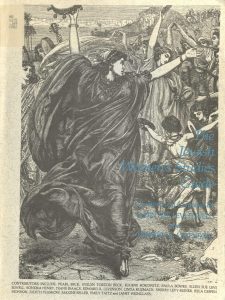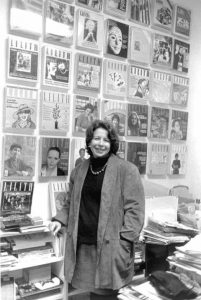As feminism gained ground within academic communities and institutions, a number of scholars sought to expand Judaic studies’ curriculum to include women’s and gender studies. Scholars aimed to frame women in Jewish scholarship within the already-existing academy, adhering to the liberal (or non-radical) practices of second wave feminism. “The  Jewish Women’s Studies Guide,” compiled by Ellen Sue Levi Elwell and Edward R. Levenson, laid out curricular models to incorporate women into historical, spiritual, and cultural Judaic studies. The guide especially considered new models of learning that strove to reconcile progressive, justice-oriented Judaism and equity between men and women within the religion. In other words, the guide went beyond the simple inclusion of female figures and elevated them to an important status on par with traditional male characters. The guide outlined courses, such as “Women in the Hebrew Bible,” that attempted to promote the already existing female characters in the Hebrew Bible, and also courses such as “Feminist Theories of Religion: The Implications for Judaism” that navigated the existential place of women in a faith constructed by and for men. The compilers of this volume state their inspiration for their work in the introduction:
Jewish Women’s Studies Guide,” compiled by Ellen Sue Levi Elwell and Edward R. Levenson, laid out curricular models to incorporate women into historical, spiritual, and cultural Judaic studies. The guide especially considered new models of learning that strove to reconcile progressive, justice-oriented Judaism and equity between men and women within the religion. In other words, the guide went beyond the simple inclusion of female figures and elevated them to an important status on par with traditional male characters. The guide outlined courses, such as “Women in the Hebrew Bible,” that attempted to promote the already existing female characters in the Hebrew Bible, and also courses such as “Feminist Theories of Religion: The Implications for Judaism” that navigated the existential place of women in a faith constructed by and for men. The compilers of this volume state their inspiration for their work in the introduction:
Feminism, both religious and secular, played a fundamental role in this new thinking…. In 1973, the National Conference on Jewish Women held in New York City attracted 300 Jews. That conference was a major catalyst for the creation of Lilith magazine and the short-lived Jewish Feminist Organization, and it inspired a special issue of Response magazine on Jewish women. (1).
Specifically citing the “special issue of Response” (later anthologized as The Jewish Woman: New Perspectives) and Lilith, this introduction summarizes the extent to which these publications were connected to and inspired by each other. Physical actions and “consciousness raising” catalyzed whole publications, which in turn made space for the creation of new academic curricula. This cycle demonstrates the effectiveness of Jewish women’s organizing and their commitment to creating tangible change in women’s intellectual, personal, and spiritual lives. Notably, both publications referenced here, Lilith and The Jewish Woman, are mainstream and certainly non-radical. Other Jewish feminist literature, such as the periodicals Sinister Wisdom and Shifra, explicitly defined their own content as radical, lesbian-feminist, and separatist.
The Jewish Woman is a lesser-known publication that was written “in the interests not only of Jewish women, but of the vitality of Judaism itself” (xx). This particular emphasis illuminates an important paradigm shift in Jewish feminism. Published in 1973 as a special issue of Response magazine, and anthologized in 1976, “The Jewish Woman” is a classic example of liberal feminism working within the systemic Judeo-Christian religion. Its editors were chosen because of their involvement with the North American Jewish Students’ Network, firmly placing the roots of Jewish feminism in the American higher education system. The book is a “spiritual quest” (1) that, while its credited authors are Jewish women, nearly all the individual writers site Talmud commentary, and the poetry in the volume is by Dylan Thomas and T.S. Eliot. Compared to other intersectional politics of the Second Wave, the feminism articulated in “The Jewish Woman” is white and even male at times. The question then remained for Jewish feminists: how can we do better?
Lilith, founded in 1976 and still publishing, is a Jewish feminist periodical with an estimated peak readership of 25,000 subscribers (Lerner). Aided by its funding and New York City publishing locale, Lilith is one of the most successful second wave publications and likely the most influential among Jewish feminists. Historian Anne Lapidus Lerner notes that “it is the activities fostered by Lilith beyond the covers of the magazine that are most distinctive. Its editor-in-chief is, for example, regularly invited to speak at the General Assembly of the Council of United Jewish Communities” and other wide-reaching public events. The magazine, in over fifty-three years of continuous publication, has covered a wide range of topics but continues to be dedicated to “foster discussion of Jewish women’s issues and put them on the agenda of the Jewish community, with a view to giving women – who are more than 50% of the world’s Jews – greater choices in Jewish life” (vol. 1, no. 1, p. 1).

Founder of Lilith magazine Susan Schneider.
Its articles stay up to date with global affairs, Jewish and non-Jewish, and it continuously integrates poetry and graphic arts throughout, and even features the occasional fiction narrative. The back of each issue ends with a section titled “Tsena Rena” (go out, see) that is subtitled “where to go for what if you’re Jewish and female.” Lilith is dedicated to providing resources for Jewish women to articulate feminism in their religious and secular lives. And while the founding of Lilith marked a certain departure from both “The Jewish Woman” and “The Jewish Women’s Studies Guide,” another decade would pass before Jewish feminists became impassioned about reforming not only their religion, but themselves.
